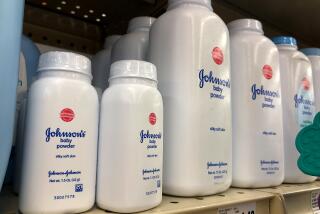Trial underway in hip implant lawsuit
Johnson & Johnson failed to warn doctors of the risks of defective metal hip implants that it didn’t test properly, a lawyer told a Los Angeles jury in the first of 10,000 lawsuits over the device to go to trial.
Loren Kransky, a retired prison guard who got an ASR XL hip implant in 2007, sued in state court in 2011 and had the device replaced last year. J&J;, the world’s biggest seller of healthcare products, withdrew the devices in August 2010 after citing British data showing more than 12% failed within five years.
“The ASR XL was dangerous and it was defective in design and we will prove it,” Michael Kelly, Kransky’s lawyer, said Friday in his opening statement. “This hip, this medical implant, incorporated dangers to an extent beyond what any reasonable doctor would have anticipated or expected.”
Kelly claimed that debris from the metal ball sliding against the metal cup caused metal ions to enter Kransky’s bloodstream, and one of his doctors said the poison would kill him without replacement surgery. Kelly said J&J;’s DePuy Orthopaedics unit knew the ASR hips were failing and never told doctors. Analysts estimate that the litigation could cost J&J; billions of dollars.
J&J; and DePuy deny Kransky’s claims, including failure to warn, defective design and negligent recall. J&J; lawyer Alexander Calfo said Friday that Kelly stitched together “snippets of emails, smidgens of depositions and sound bites of memos” to paint a false picture of DePuy.
“When you hear the evidence of what actually happened with Mr. Kransky, you will see that story you just heard really isn’t the story,” Calfo told jurors. “DePuy is simply not the company the Kransky lawyers claim.”
J&J; faced 10,100 lawsuits through September, according to a regulatory filing. Most pretrial collection of evidence is consolidated in federal court in Toledo, Ohio, where 7,240 cases are pending; and California state court in San Francisco, where more than 2,000 cases are filed. Other cases were filed in state courts around the U.S.
The company said in January 2012 that it had spent about $800 million on hip recalls during the prior two years. J&J; didn’t provide an estimate of its product-liability costs.
J&J; offered to pay more than $200,000 a case to settle most of the 10,000 lawsuits, according to five people familiar with the matter. The deal’s cost could exceed $2 billion if most plaintiffs accept the terms. Lawyers for hip recipients have so far rejected the offer, the people said.
Kelly said DePuy designed a metal cup that was supposed to stay squarely in the hip and not shed debris into the body. The design failed on both counts, he said, releasing cobalt and chromium debris into patients as the cup loosened, he said. DePuy did limited testing in machines and not people, he said.
“They chose not to do a controlled clinical study on people,” Kelly said.
DePuy, which sold the device around the world, began getting reports of problems as early as January 2005, he said. He cited a June 2005 email from an Irish marketing official who said she was “quite concerned about our failure rate.”
She also wrote an email in June 2006 about a doctor in the Netherlands who was considered a “key opinion leader” and who conducted a study that found “significant failure for the ASR,” according to Kelly. The doctor said he wouldn’t implant the device anymore, Kelly said.
Kelly said that in October 2011, Kransky had as much as seven times the normal level of cobalt in his body. Cobalt, he said, kills human cells.
Calfo said that cobalt and chromium from the ASR hips don’t poison patients, including Kransky.
“The ASR was thoroughly tested and was researched before it was ever used,” Calfo said.
Kransky’s diabetes, high blood pressure and elevated cholesterol caused his health problems, Calfo said.
More to Read
Inside the business of entertainment
The Wide Shot brings you news, analysis and insights on everything from streaming wars to production — and what it all means for the future.
You may occasionally receive promotional content from the Los Angeles Times.








